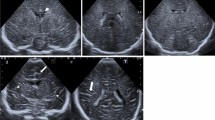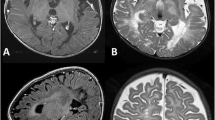Abstract
Although imperfect, MRI is the best way of distinguishing type 1 lissencephaly from other, less classical lissencephalic malformations. We reported a case in which correlation of MRI and neuropathology was possible. Besides the classical radiological features of lissencephaly, i. e., agyria and excessive thickness of the cortex, an additional sign was observed: a thin cortical band, which gave high signal on T2-weighted images, represented a paucicellular and partially myelinated band, 1500 μm thick, lying under the true superficial cortex. This MRI feature could be characteristic of the particular cortical lamination observed in true type 1 lissencephaly.
Similar content being viewed by others
Author information
Authors and Affiliations
Additional information
Received: 6 January 1997 Accepted: 7 July 1997
Rights and permissions
About this article
Cite this article
Landrieu, P., Husson, B., Pariente, D. et al. MRI-neuropathological correlations in type 1 lissencephaly. Neuroradiology 40, 173–176 (1998). https://doi.org/10.1007/s002340050562
Issue Date:
DOI: https://doi.org/10.1007/s002340050562




